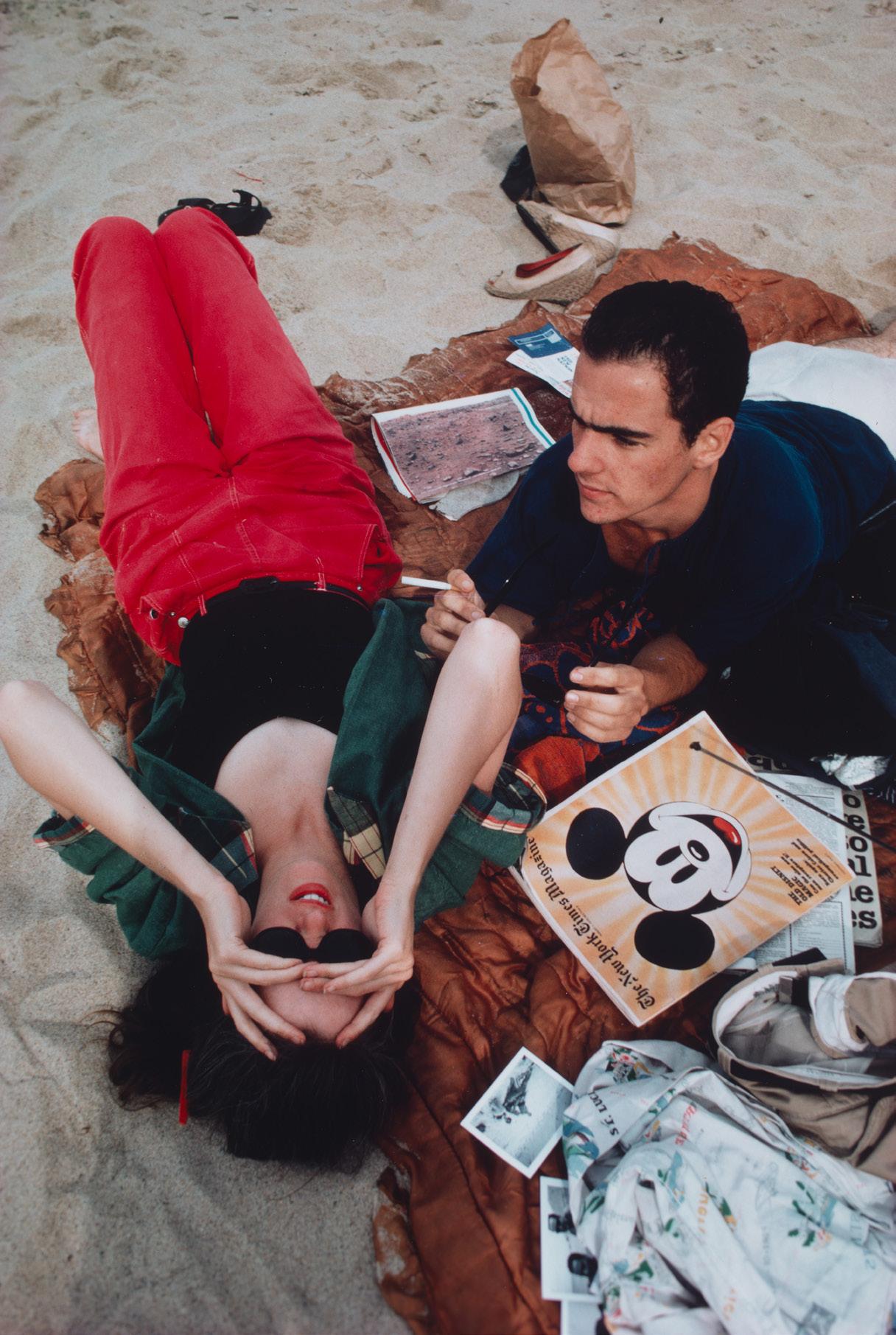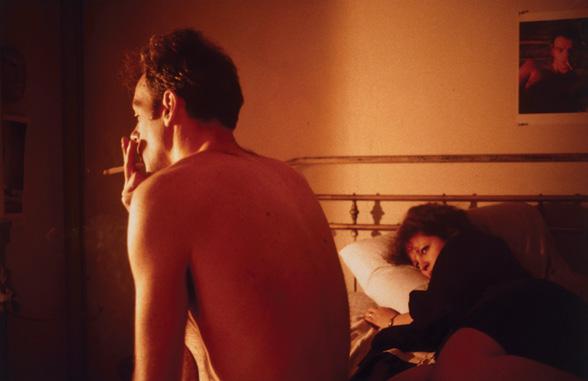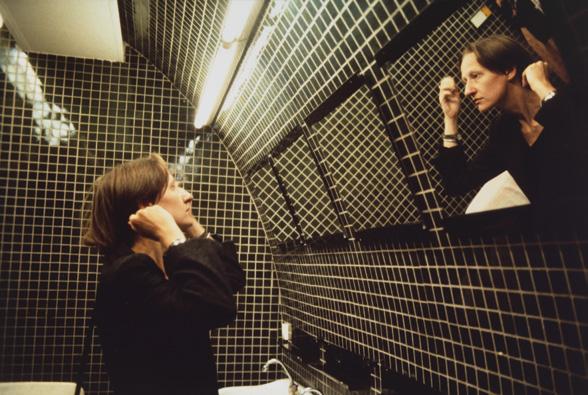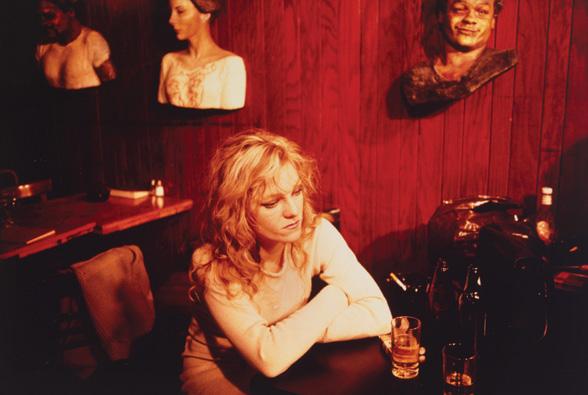
It’s about trying to feel what another person is feeling. There’s a glass wall between people, and I want to break it.
Nan Goldin
When she arrived in New York in 1978, Nan Goldin became a part of a vibrant, unruly community made up of artists, actors, filmmakers, musicians. Gritty. Pre-gentrification. They saw themselves as heirs to the freewheeling sexually-fluid days of Weimar Germany, in punky rebellion against the conservatism and values of mainstream America. Goldin lived by night, working in bars, making ends meet. She had studied photography in Boston and to this community, her community – congregating in the Bowery, the cheap, rundown neighbourhood in the Lower East Side – she brought a commitment to documenting her life and those around her as honestly as she could. Her camera accompanied her everywhere. Lacking access to a darkroom, Goldin had shown her work at art school by projecting slides. Now she started showing her photographs as slideshows in underground clubs, arranged into themes and performed with a soundtrack. This ever-shifting, ever-evolving visual diary of her life would coalesce in time into The ballad of sexual dependency. The people in the audience were the people in the images. The slideshow was a gift to her community. Nan’s photographs perform like “a caress”ii – she had to feel a connection for the image to work. Her intent for those she cared about was to see themselves as she saw them, as beautiful.

Each showing was much anticipated; it didn’t take long for word to get out and for Goldin’s audience to expand as The ballad began to be included in museum shows. In 1985, the slideshow was shown at the Whitney Biennial and the following year the Aperture Foundation published The ballad as a photobook comprised of a selection of 126 images from the 700 or so that made up the slideshow. The images in the book were also printed as Cibachrome prints in an edition of ten. The National Gallery acquired the last set in the edition in October 2021 from Goldin’s personal collection. Intensely saturated, glossy, almost impossibly seductive, the prints pulsate as the projected slides had, as if lit within. Goldin doesn’t see very well and perceives the world in hazy blocks of colour. Her use of blurry focus and veils of colour pull us in. It’s as if the emotion has bled across the surface of the image. Her snap-shot aesthetic makes her compositions casual and immediate. It’s as if we, too, have just stumbled upon these scenes. No one does it quite like Goldin.
Goldin often refers to the people in her images as her superstars and it is how I have come to think about them as well: “they become”, she has stated, “a star in the movie of my life”.iii Some of them have achieved a cult following without Goldin; Cookie Mueller, queen of the Lower East Side, author, performer and actor is the most obvious


person in this regard. But others, like Suzanne Fletcher, a minor actor who reappears throughout The ballad, is a ‘superstar’ because of Goldin and the love between them. Their friendship went right back to high school, back to before Goldin picked up a camera. Back to when Goldin turned up still bereaved and broken, silenced, following the suicide of her beloved older sister three years earlier. Such closeness results in some of the most affecting, the most moving images in The ballad
Because of the trust that Goldin was able to build, we see her friends in moments of great openness where performance falls away. We see Suzanne travelling with Goldin, off to Berlin or Mexico, in her parents’ house, in her parents’ bed. Lost in an all-consuming embrace with her boyfriend of the time, in the shower, found staring at herself in mirrors and (for me the most emotionally raw image in The ballad) crying. It’s a supreme moment of courage and connection. At the time this level of disclosure and self-disclosure was exceptional in photography.
The privileging of friendships and a recognition of the vital role that it plays in our lives is what makes The ballad a call to arms at a time when societal convention saw the nuclear family and romantic love and marriage as the path to happiness. It is what made it radical in its time and perhaps why it continues to engage and move us. As Goldin has said, the one good shrink she went to told her that she had only survived because by the age of four, her friends were more important to her than her family. As she makes very clear: “They’re the most important to me in the world, my friends. More important than family, lovers, my career.” iv
Goldin’s commitment to caring for her friends and her community is one that has remained consistent, at the very heart of her practice and life. Perhaps in humanist terms, Goldin’s greatest achievement, her almost magical attribute, is her ability to bring people together to see themselves as a community and see the power that comes with that recognition. Through the way The ballad unfolds, she draws us into this space – one where Goldin’s love and empathy for those she photographs is palpable. The images become collaborative and audacious acts of generosity on both the part of the photographer and the subject.
Anne O’Hehir Curator, Photography, National Gallery of Australia
David Armstrong, Nan Goldin, Elisabeth Sussman et al (eds), Nan Goldin: I’ll be your mirror, Whitney Museum of American Art, New York, Scalo, Zurich, 1996, p 448.
ii Nan Goldin and Taka Kawachi (eds), Couples and loneliness, Korinsha Press, Kyoto, Japan, 1998, p 58.
iii Nan Goldin, interview by Hillary Weston, ‘Feeding the appetites: Nan Goldin’s movie obsessions’, 10 September 2020, https://www.criterion.com.
iv ‘Una Mullally, ‘Nan Goldin and Vivienne Dick: extraordinary art, extraordinary friendship’, The Irish Times 1 July 2017, https://www.irishtimes.com/culture/art-and-design/nan-goldin-and-vivienne-dick-extraordinaryart-extraordinary-friendship-1.3135795
Viewer Advice: The photographs in Nan Goldin: The ballad of sexual dependency depict the everyday lives, often in intimate detail, of people in Goldin’s immediate community during the late 1970s and early 1980s.
Content Warning: Please be advised that works of art in Nan Goldin: The ballad of sexual dependency depict explicit nudity, sexual acts, drug use, and the impacts of violence against women. Viewer discretion is advised.
This publication supports the exhibition Nan Goldin – The ballad of sexual dependency 4 July - 14 September 2025
Text copyright ©National Gallery of Australia, 2025.
The ballad of sexual dependency is a National Gallery of Australia touring exhibition presented as part of the Bowness Family Foundation Touring Photography Exhibition series.
@johncurtingallery
gallery@curtin.edu.au
www.curtin.edu.au/jcg
